Professional Certification
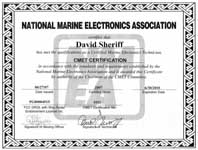
 CMET - The
National Marine Electronics Association (NMEA) awarded David Sheriff a
Certified Marine Electronics Technician rating,
certificate serial 1021, on June 27, 2007. This certification is actively maintained by approximately 150 of the top marine electronics technicians in the USA. The certification is awarded
upon passing an examination, demonstrating sufficient experience and possessing
an FCC GROL license with radar endorsement. The
certificate is maintained by actively pursuing continuing education.
Electric Marine is now rated a CMET Certified
Dealer.
CMET - The
National Marine Electronics Association (NMEA) awarded David Sheriff a
Certified Marine Electronics Technician rating,
certificate serial 1021, on June 27, 2007. This certification is actively maintained by approximately 150 of the top marine electronics technicians in the USA. The certification is awarded
upon passing an examination, demonstrating sufficient experience and possessing
an FCC GROL license with radar endorsement. The
certificate is maintained by actively pursuing continuing education.
Electric Marine is now rated a CMET Certified
Dealer.

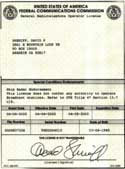 I
hold a General Radiotelephone Operator's License with a Ship Radar
Endorsement issued by the Federal Communications Commission issued on
April 4, 2002. The exam for this license establishes the holder's
knowledge of the technical and legal knowledge required to make
adjustments and repairs of marine radio and radar.
I
hold a General Radiotelephone Operator's License with a Ship Radar
Endorsement issued by the Federal Communications Commission issued on
April 4, 2002. The exam for this license establishes the holder's
knowledge of the technical and legal knowledge required to make
adjustments and repairs of marine radio and radar.
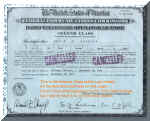 As
a young man, I worked as an engineer in broadcast radio and television and
held equivalent FCC licenses. The Second Class license, issued on
September 16, 1968, covered the technical knowledge required to operate
and repair broadcast stations. Back then, virtually everything that
had been in service for a while contained vacuum tubes.
As
a young man, I worked as an engineer in broadcast radio and television and
held equivalent FCC licenses. The Second Class license, issued on
September 16, 1968, covered the technical knowledge required to operate
and repair broadcast stations. Back then, virtually everything that
had been in service for a while contained vacuum tubes.
Vacuum tube equipment was not particularly reliable and I maintained and repaired large radio transmitters on both a routine and emergency basis. Routine maintenance consisted of logging operational parameters to ensure that the station continued to operate within it's licensed conditions. When some parameter began to drift out of specification, I diagnosed the problem and made the necessary repairs. I kept a Collins Radio 10 kW AM transmitter and a Collins 15 kW FM transmitter running for several years at WAUK in Waukesha Wisconsin. The AM transmitter was much less reliable, particularly in it's three-phase mercury-vapor rectified 5000 volt power supply. It was quite a beast. I'll try to find a photograph. The Wikipedia article shows only Collins' amateur radio equipment.
 I
also worked on several other transmitters on a part-time and
vacation-replacement basis. This included Milwaukee's WQFM just at
the point where it was being sold and converted to a rock station.
I
also worked on several other transmitters on a part-time and
vacation-replacement basis. This included Milwaukee's WQFM just at
the point where it was being sold and converted to a rock station.
My FCC First Class license, required to assume technical responsibility for a commercial station, was issued a month after the second class license on October 31, 1968. The exam was structured in parts. The technical parts qualified you for the second-class license. Additional legal material plus the technical stuff qualified for the First Class license. I has pretty much learned the technical material as I grew up. I knew how vacuum tube electronics worked. I got a handbook and studied for a few days and traveled to Chicago to the FCC field office and took the test. To divide up the study time, I took the second class exam first. With that license in-hand, I took the First Class exam. That's why the license dates are only a month apart. The second class license was cancelled when I got the First. The license term ran for five years and was renewable. I held the license for 10 or 15 years.

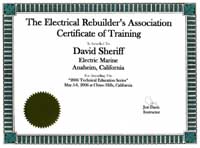 ERA
- I do not ordinarily repair alternators and starter motors, but I
know how to go about it. I attended a weekend workshop in 2006
sponsored by the Electrical
Rebuilder's Association. It's not exactly a professional
certification, but they sent all the attendees a training
certificate. I learned a few new tips about these components and how
to determine if they are good or bad. Generally, if I need an
alternator or starter rebuilt, I take it to Lewco
Electric in Costa Mesa. They do good work, and if there is ever
a problem, they stand behind their work as well.
ERA
- I do not ordinarily repair alternators and starter motors, but I
know how to go about it. I attended a weekend workshop in 2006
sponsored by the Electrical
Rebuilder's Association. It's not exactly a professional
certification, but they sent all the attendees a training
certificate. I learned a few new tips about these components and how
to determine if they are good or bad. Generally, if I need an
alternator or starter rebuilt, I take it to Lewco
Electric in Costa Mesa. They do good work, and if there is ever
a problem, they stand behind their work as well.
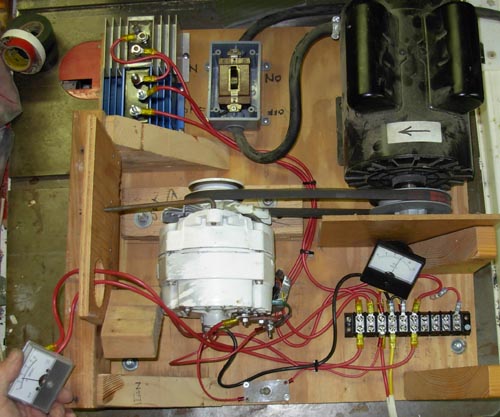 Following
the workshop, I built an alternator test stand, which I keep in my
shop. It has a 5 horsepower 3450 RPM motor to drive the alternator
under test. This usually gets the alternator above 4500 RPM, well
into it's operating range. I can push over 50 amps into a test
battery and resistive load.
Following
the workshop, I built an alternator test stand, which I keep in my
shop. It has a 5 horsepower 3450 RPM motor to drive the alternator
under test. This usually gets the alternator above 4500 RPM, well
into it's operating range. I can push over 50 amps into a test
battery and resistive load.
The stand is useful in those instances where it is somewhat unclear whether a charging problem is with an alternator or with it's installation. It's also useful in setting the voltage regulator or for testing voltage regulators under real conditions.
The test stand was also useful to allow me to put different alternators through their paces, which helped solidify my understanding of how they work.
My camera apparently has a pretty fast flash/shutter as the test stand was in operation when the photo was taken and everything looks like it's standing still. The built-in meters give me a guide to performance, but for accurate measurements I use my usual diagnostic tools, which have a voltage and current accuracy on the order of a few percent.